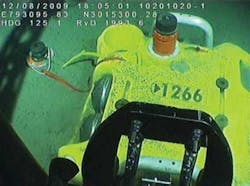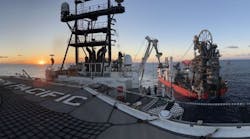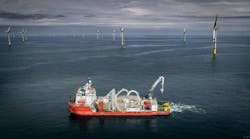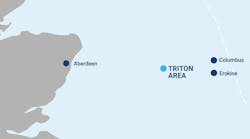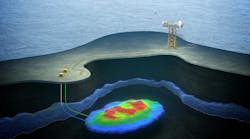Real-time data, subsea configurations join traditional solutions
Richard Kluth
Pulse Structural Monitoring
Structural monitoring plays a vital role as operators drive out into greater water depths with ever more complex production riser configurations.
Petrobras' Guará-Lula NE development, when completed in 2013, will be a remarkable feat of subsea engineering, involving four 2,000-metric ton (2,204-ton) submerged buoys supporting 27 steel catenary risers (SCRs). It is also one of a growing new generation of projects to incorporate a full structural monitoring campaign in its tender. At BP's block 31 installation off Angola, a comprehensive real-time monitoring system will play a pivotal role, from inception of the project through to decommissioning.
History and evolution
Structural monitoring has been evolving constantly for decades, yet only in the last few years has it been fully recognized as a vital E&P ingredient. This trend has accelerated since the Gulf of Mexico Macondo spill last year, as operators and contractors seek to better understand their risk exposure to structural issues.
As with most offshore innovations, there has been a certain "wait and see" attitude to monitoring, with operators reluctant to commit until the technology is field proven. But these barriers have lifted gradually following a series of successful deployments, demonstrating how monitoring systems can be integrated into subsea infrastructures.
Early concerns over performance and expense have been addressed, with advances in manufacturing techniques enabling production of high quality components at a lower cost, making monitoring technology more reliable and economical. In the past, the regular need to replace drained batteries and retrieve full data loggers virtually negated the lower maintenance benefits of monitoring over inspection. Now, however, improved power efficiency and increased memory capacity mean that modern systems can now be left in-situ for more than five years.
An ongoing monitoring campaign allows the operator to continually gather data throughout all conditions, whereas inspection can only be conducted at discrete events, often dictated by weather or metocean conditions, and must be performed frequently to avoid damage going unchecked.
General principles
As offshore projects become more ambitious in terms of complexity and longevity, monitoring technology will continue to adapt, providing novel application of simple tried and trusted technologies, based on a consistent set of solid principles.
Of these, perhaps the most significant is strain measurement, which comes in two forms: the absolute strain measurement (i.e. the numerical distance from the value zero); and dynamic strain (the relative changes in the structure).
Absolute strain is measured to determine whether a riser has suffered a specific instance of compression or over-tensioning, either of which can compromise riser integrity, even causing buckling or collapse. Dynamic strain measurement captures the shifts in values as a structure moves. It is used to calculate its fatigue history and expected lifespan.
Traditionally, strain data has been captured using paper-thin gauges no bigger than a thumbnail, bonded directly to the surface of the pipe using epoxies or welds, followed by several layers of protective insulation. This method is understood, unobtrusive, and relatively low-cost but, despite having been refined over many years, can be susceptible to water ingress if not adequately protected.
Alternatively, hermetically sealed displacement and dynamic curvature sensors can be mounted to the outer surface of the riser, either inside or outside the insulation, depending on the specific configuration. These sensors, designed to operate in water depths of over 3,000 m (9,842 ft) and to last 25-years, provide accurate and reliable readings of axial and bending stresses, with minimal need for intervention.
Motion measurement is a valuable tool in calculating the fatigue life of subsea structures that are subjected to varying conditions. Vortex induced vibration (VIV) is an oscillation caused by water moving past a riser and is a concern in regions with severe currents. Marinized accelerometers and angular rate sensors are used to capture motion data. Analysis of this data can help operators understand the modal shape of risers and determine their fatigue life.
Pressure data, which provides an understanding of internal stresses and flow, traditionally is captured using intrusive sensors that penetrate the riser. However, this method not only presents a potential leak path, but can be prone to blockage. So, operators are turning increasingly to the use of non-intrusive technology to measure hoop strain on the riser and to calculate pressure.
Technological advances
While these and other principles are common to most modern structural monitoring projects, this does not mean that all projects can be reduced to one set of principles. Each tender demands a unique approach, taking into account variables such as riser configuration, water depth, metocean conditions, and hydrocarbon characteristics. The art of monitoring is in understanding these parameters, knowing how to apply the principles, and continually innovating to achieve greater accuracy and reliability.
In 2006, Pulse implemented a riser and flowline monitoring (RFM) campaign for Chevron's Tahiti project in the Gulf of Mexico, fully hardwired with double redundancy and with a life of at least 10 years (an industry first at the time). Chevron demanded real-time data to validate the integrity of its steel catenary risers, which Pulse achieved by fixing strain and motion sensors along the risers at the hang-off and touchdown zones to chart their responses to VIV, waves and currents, and to gather information on riser to seabed interaction.
Flexible risers are gaining popularity, particularly offshore Brazil. Their flexible nature makes them ideal for use on FPSOs and other floating vessels, while their capacity for being recovered and redeployed gives operators added versatility in their field development strategies.
However, continual movement in strong currents and exposure to extreme pressures in deepwaters can render them vulnerable to damage and integrity issues. Wire-break technology, as employed by Pulse's new FlexASSURE riser monitoring system, is designed to combat these problems, as it is able to detect breaks in individual armor wires that form the riser to build a detailed picture of structural integrity and provide an early warning of failure.
In the case of free-standing risers, monitoring the upthrust provided by the supporting buoyancy tanks and the integrity of the connecting chains is critical to ensuring their safe operation. If a tank takes on water and begins to sink, the riser can buckle. So, absolute strain measurements are taken from the riser to calculate the upward thrust.
A chain failure can cause the buoyancy tank to break free, leaving the unsupported riser to collapse, as happened earlier this year at Petrobras' Cascade-Chinook development. Out of plane bending of chain links can cause rapid acceleration of fatigue, with even small bends significantly increasing risk of failure.
The most common method of monitoring chains has been to apply instrumented shackles, although uneven loads on the pin can cause inaccurate readings over time and, ultimately, failure. These issues led to the development of monitoring H-links, which overcome these problems by taking direct inline tension measurements at a natural joint. Pulse has collaborated with InterMoor to pioneer this technology with the Inter-M Pulse monitoring system, due to enter production later this year.
Looking to the future
The way captured data is used is changing, with less focus on offline logging campaigns and a big increase in demand for real-time information. Although still relatively young, subsea acoustic technology is advancing fast after addressing initial problems with reliability and battery life. The Macondo clean-up operation was testament to its abilities, with acoustic communications operating flawlessly in an area with up to 40 vessels at any one time.
However, the more traditional hard-wired communication still has advantages, such as power delivery and increased bandwidth. Former concerns, such as the vulnerability of wires to snagging from divers or ROVs and damage in splash zones during harsh weather, have been overcome, as demonstrated by the continuing success of the hard-wired solution deployed in the Tahiti development.
Recent years have brought developments in fiber-optic technology, such as distributed acoustic sensing (DAS) to detect and locate potentially damaging events along pipelines. While such systems are achieving results on land, their usefulness subsea has yet to be firmly established. In general, there has been a slow uptake on fiber optic technology, perhaps because it is harder to install, draws more power, requires special connectors, and does not yet offer clear advantages over electronic sensors.
The relationship between monitoring companies and operators is strengthening, but building communication between the two parties, manufacturers, and contractors is key to future implementations. Sharing expertise throughout every stage of a project and integrating technologies will help make campaigns safer, more efficient, and more economical.
Offshore Articles Archives
View Oil and Gas Articles on PennEnergy.com



